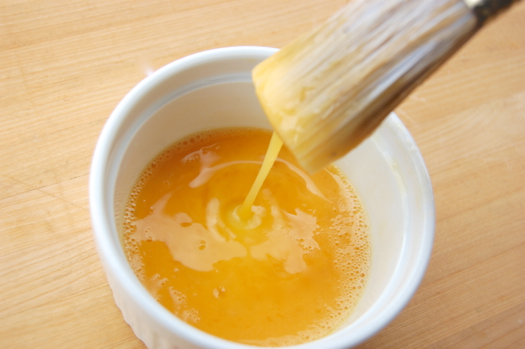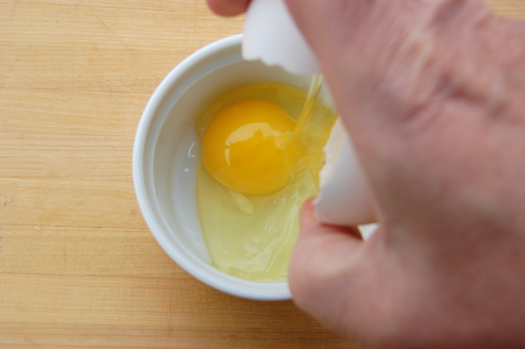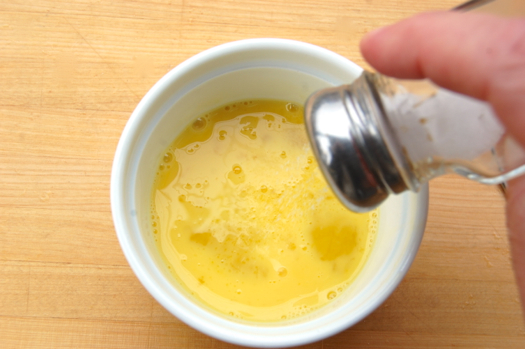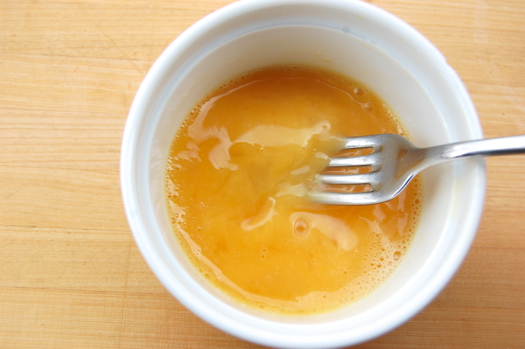Making Egg Wash

Since the simplest things can often cause great confusion it seems well worth doing a proper tutorial on the subject of egg wash. I should say straight out that while I am aware of all the possible additions to an egg wash, I’m not a big believer in the benefits of that alchemy. Unless you’re very much into the minute details of presentation — and I’m clearly not — a simple wash made of well-beaten whole egg plus a dash of salt will do you for most any job. Multi-ingredient washes made from egg, cream, water with a dash of sugar…homey don’t play dat. Here’s what I do: crack an egg.

Give it a swizzle.

Mix in a couple sprinklings of salt.

What will this do aside from seasoning it? Good question. It will cause the mixture of liquid yolk and semi-gelatinous white to relax into an even, water-like solution. How? Well you’ll recall what I’ve written before about egg white proteins. In their natural state they occur in little bunches scattered throughout the white. Well I suppose I shouldn’t say “scattered” exactly, since the fresher the egg white is the more those little bunches are attracted to each other. They end up clustered together and it’s this clustering that makes a very fresh egg white thick and even a little milky in color as all those clustered protein bunches bounce light rays back to our eyes.
Add salt and that situation changes. The protein bunches aren’t nearly so attracted and in fact start to repel each other a little. Something like this happens as an egg gets older and the pH of the white naturally starts to rise. The little protein bunches spread out, making the white both thinner and clearer. But I digress. After about ten minutes I return to my egg wash which has thinned considerably as the protein bunches pushed away from each other. It has also darkened considerably. Don’t ask me why, I don’t know. What am I, some sort of encyclopedia or something?

Perfecto. Smooth and even, ready for painting on without glops.

I should add that you don’t want to fall into the trap of thinking that if a little bit of salt in the wash is good, a lot must be even better. Don’t go adding half a teaspoon or something crazy like that since too much salinity has the reverse effect on the proteins, causing them coagulate. You don’t want that since it means curds and blobs of egg all over your buns. Or Danishes…whatever you happen to be doing. All clear?
The last batch of sandwich bread I made included an egg wash with a little water and a tablespoon of honey – crust came out a little crispier than usual, but with a brilliant sheen and touch of sweetness. Of course, I had to whip it a bit more to get that honey well incorporated to the chilly egg…
Very interesting. I may well try that one of these days!
Cheers,
– Joe
Add some paste food color and you have “paint” for cookies.
Love that!
Thanks, Rainey!
-Joe
I’ve used egg wash before but did not care for the texture it gave my pie crust. It made the surface slightly gummy, for lack of a better description. It was even worse the next day when the crust had picked up some moisture from the filling below. I’m thinking now that I didn’t add salt and that made the difference, right? I’ve also read where people have complained about egg wash not rising with their loaf of bread. How do you handle a patchy surface in the case of bread?
Hey Susan!
That may well have been the case, though I generally don’t paint egg wash on pie or tart crusts. In my view it isn’t needed. Egg washes are much better for buns, rolls and laminated pastries like Danishes and croissants. But you’re right, often they aren’t flexible enough to go onto something like a bread loaf without cracking. In that case you definitely do want to add some cream to the mix. The fat gives it some elasticity.
Thanks for the question!
– Joe
Oooooh, salt. All these years and I tried to wash things with a separated muck of yolk and white and now I finally realize I just need to put in salt.
Yep! It’s amazing the difference that it makes, Amanda. Have fun without the goop! 😉
– Joe
I, like you, believe in a simple egg wash myself. I whip the eggs, then strain them through a fine mesh strainer to get rid of all the albuemen. After that they are pretty easy to use. Also means I can use the eggs in my dish as I use a scale and measure everything in grams for my recipies. So I can crack, whip, strain all the eggs I need once when baking.
I like that, Toby!
Thanks for the comment!
– Joe
Egg wash for painting things to get a nice brown in the oven and egg wash for making say, breadcrumbs stick to the outside of something to be fried are different stories though. Seasoning is always good, but for stickage, watering down the egg by 50% or more doesn’t hurt at all… there’s still enough protein to keep things stuck once it starts cooking.
One thing I really like instead of egg wash on sweet breads, like a nice brioche, is a mix of milk and water. Gets you really nice shine on the outside and like Roger said, a nice sweetness. And since you’re mixing with milk, just heat the mixture before beating and the honey won’t be an issue!
Very nice, Pete! Thank you for an excellent comment!
– Joe